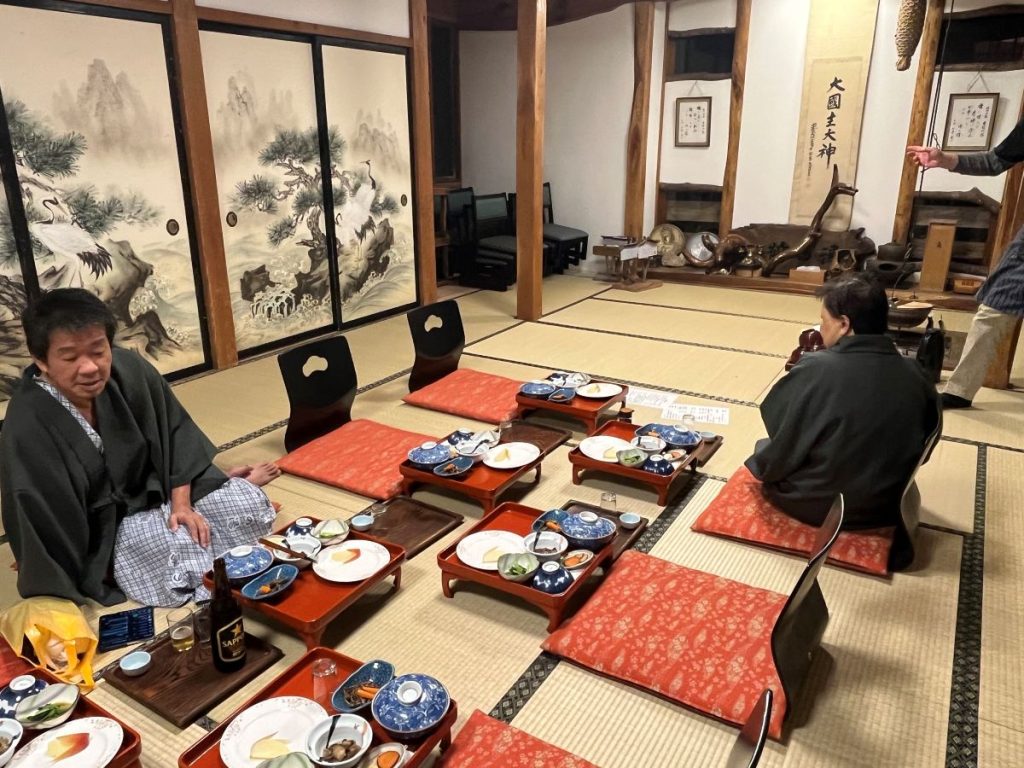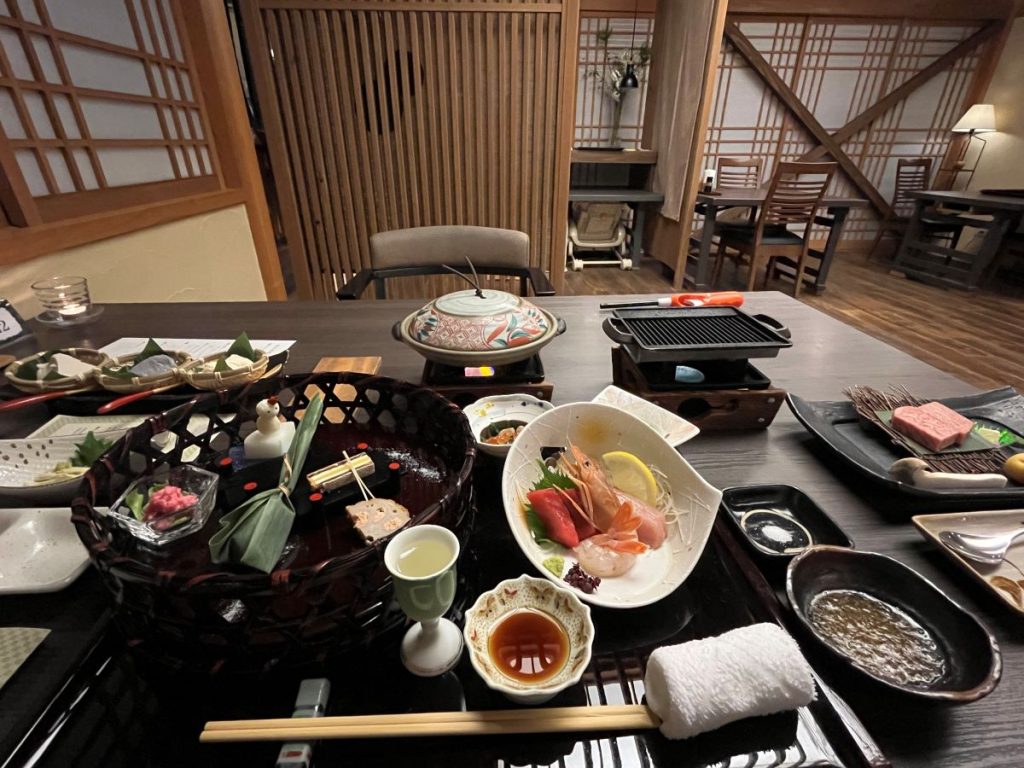
Meals on tatami mats. (©Daniel Moore)
Japan is a popular destination because of its history, unique culture, and oddities. While some aspects of Japan are incredibly convenient, others can be uncomfortable, unfamiliar, or outright strange for visitors. At the same time, the good, the bad, and the "only in Japan" moments are what make this country fascinating. Losing them by conforming to the world would mean losing part of Japan's soul.
Japan is being flooded with tourists at unprecedented levels. With that arise opportunities and challenges. For example, international visitors request all types of concessions to their culture, dietary habits, or customs. That means Japan faces the challenge of maintaining its culture while accommodating where possible. Should it adapt or remain the same?

The catalyst for this article was a recent encounter between a customer and an employee at an Italian restaurant. The customer repeatedly demanded in English, "No wheat, no cheese, no meat," like a hypnotic chant getting louder and louder.
My inner cynic screamed "Why did you choose Italian?" but I suppressed the thought, keen to hear the remainder of the interaction. With little English forthcoming, the employee showed her the laminated sheet of vegan and gluten-free options.
Unfortunately for her, none of the options were both gluten-free and vegan. Exasperated, the customer complained about an entire nation's dearth of dietary choices. The employee looked flummoxed and apologetic, not being able to understand or speak for the rest of Japan.
I briefly considered translating to ameliorate the situation but decided I couldn't help. The only advice I contemplated sharing was, "Go find a convenience store with more options," but she was probably eating Italian because she was tired of 7-11.
Soy Sauce on Rice
Unlike America's Burger King culture of "have it your way," menus in Japan are not typically customizable. Restaurants prepare ingredients in advance, or the chef creates the menu based on the season and his experience.
The most common condiment request is the one I most loathe translating. The inevitable question when a bowl of plain, white rice appears … "Could I have some soy sauce, please?"
What I want to say is "Absolutely not." Putting soy sauce on white rice is like eating toast with ketchup. A child might do it, but adults grow out of it. However, these are customers, so reluctantly and obediently I translate, explaining the context to the Japanese waiter about the unusual request.
My explanation goes something like, "I'm so sorry, they're not accustomed to eating rice by itself so they need more flavoring." The staff members are either bemused or disgusted but comply.

'Semi-Japanese' Experiences
The two uncomfortable parts of traveling in Japan for many visitors are sitting or sleeping on the floor and Japanese-style squatty potties. However, squat toilets are rare, increasingly replaced by modern washlet toilets that have leapfrogged Western toilet technology by several decades. The modern Japanese toilets are so civilized it's hard to go back. My parents even imported one for their home in Colorado. Apparently, there are now plumbers specializing in installing washlet toilets.
Sleeping and sitting on the floor becoming less common, but not just because of tourists. Older Japanese people are also finding it difficult to center their lives around the floor. Many traditional Japanese ryokans provide chairs or place a Western-style bed on the tatami mat for a "semi-Japanese" experience. I call this style "Japanese aesthetic with Western comfort."
In the cities, restaurants that sit on the floors are quickly vanishing. For better or worse, Japan is adapting to international standards by using tables, chairs, and beds. The Western style makes it easier to visit Japan, but part of me feels nostalgic about losing a part of Japanese culture.

Minor Inconveniences
Two inconveniences in Japan are removing shoes and the lack of trash cans. These are not changing anytime soon. Taking off shoes is a quintessential aspect of Japanese culture. Everything from houses to hot springs is designed with removing shoes in mind. Although inconvenient, I tell people to bring slip-on shoes or tie their sneakers loosely. Besides, not wearing shoes inside is just good hygiene. Why would you want to track all that dirt inside?
Pro Tip: Many visitors are confused about where to remove shoes. Whenever you step up into a house, it's a sign to remove shoes. For establishments like restaurants, look around to see what Japanese people do.
Public garbage cans are also a rare attraction. The idea is that whoever created the trash is responsible for it. Despite its inconvenience, I believe Japan is clean because of the lack of trash cans. Because few trash cans exist, everyone brings a trash bag or tries to create less waste. Rarely do you find people littering.
You could never remove trash cans from public places in North America or Europe because people would riot. But Japan is different. While in Japan, get into the trash reduction mindset because creating too much trash will put you in a pickle.
Pro tip: Although public trash cans are rare, anywhere you pay to enter will have a trash can.
Fish for Breakfast
Another challenge is breakfast. While most people say they appreciate Japanese food for lunch and dinner, a fish eyeball staring back at you in the morning is another matter.
I have mixed feelings about breakfast. Personally, I eat Western food at home. However, a ryokan is a traditional Japanese-style accommodation that serves fresh, seasonal, and local food. Some inns have operated for decades or centuries. Who am I to say they should change their menu to suit my preferences?
Food is also inseparable from culture, so I want people to experience authentic Japanese food, including breakfast. However, I also understand religious, health, and ethical reasons for dietary restrictions. And people have their preferences that they cannot change.
It's most convenient when hotels offer Western and Japanese-style breakfast options, but it's not always possible. I wish everyone were more open-minded and adventurous with food, but I also understand that during a long trip, sometimes you need a good bowl of cereal.

Smoking in Bars
Many people express shock that it's still legal to smoke indoors in Japan. In reality, the owner of the establishment can decide whether they allow smoking. While I hate cigarette smoke, business owners should have the right to choose, knowing that they will gain some customers and lose others. Japan shouldn't place a blanket ban on smoking because visitors don't like cigarette smoke. They don't have to visit that bar if they don't like it.
Conclusion
Japan should not have to adapt to the world in every way because it will lose parts of its identity. People visit Japan because of its quirky uniqueness — because it's so different from everywhere else. However, business owners should be able to decide when and how much to change their aesthetics, amenities, menu, or facilities to suit the customer's needs.
As an Airbnb owner, I constantly adapt based on customer suggestions, weighing the pros and cons. But when customers can't find gluten-free vegan pasta at an Italian restaurant, they should understand that it's not Japan's or the restaurant's fault.
RELATED:
- Visitors Beware: Be Sure to Lock Up Your Shoes
- The Quirky Side of Japanese Hiking Culture
- 'Itadakimasu Culture' A Daily Reminder to Be Thankful
- What Tour Guiding Taught Me: Always Take the Pen and More Life Lessons
Author: Daniel Moore
Learn more about the wild and wonderful sides of Japan through Daniel's essays.






